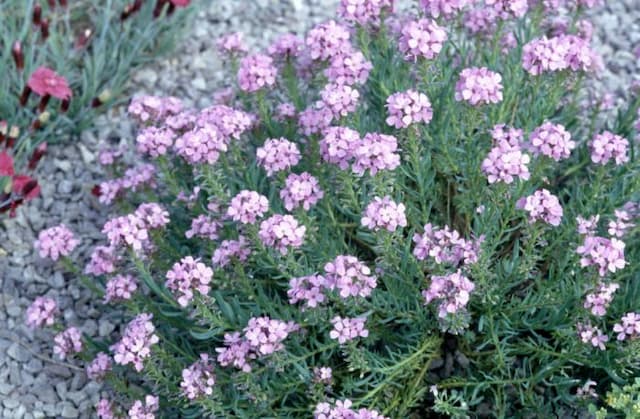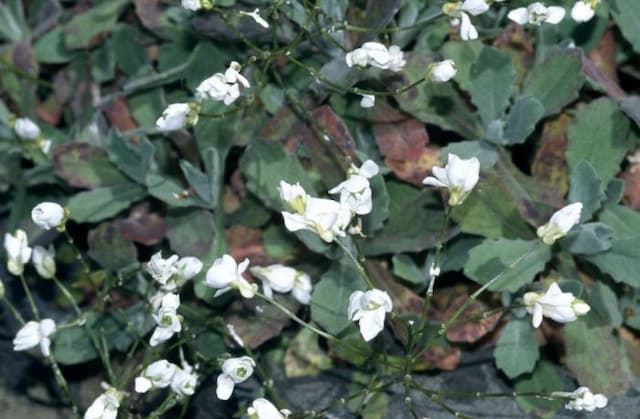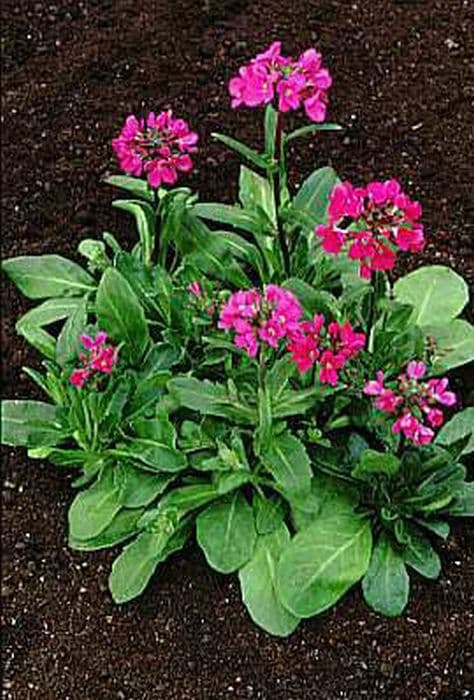Mountain Gold Alyssum montanum 'Berggold'

ABOUT
The Alyssum montanum 'Berggold', commonly known as Mountain Gold, is a delightful perennial plant known for its vibrant display of flowers and foliage. It has a low-growing, mat-forming habit with dense clusters of tiny, bright yellow flowers that create a striking contrast against its foliage. The leaves are small, greyish-green in color, and possess a slightly hairy texture which provides a beautiful silvery effect. The flowers of Mountain Gold are characteristically four-petaled, arranged in dense clusters that blanket the foliage in a golden yellow carpet when in bloom. This profuse bloomer exudes a sweet, honey-like fragrance that adds to its allure, attracting a variety of pollinators, including bees and butterflies. Its foliage remains an attractive feature even when the plant is not in flower, often used to provide a splash of color in rock gardens, along borders, or as ground cover. The overall visual appeal of Mountain Gold lies in its lush carpet of flowers and the subtle charm of its silvery leaves, which together create a picturesque display of color and texture.
About this plant
 Names
NamesFamily
Brassicaceae
Synonyms
Mountain Alyssum, Mountain Gold Alyssum, Golden Alyssum
Common names
Alyssum montanum var. gmelinii, Alyssum gmelinii, Alyssum montanum subsp. gmelinii.
 Toxicity
ToxicityTo humans
Mountain Gold is not known to be toxic to humans. Generally, if a plant is not specifically noted for being poisonous, it is not considered to pose a significant risk if ingested. However, it is always prudent to avoid eating any parts of ornamental plants unless they are known to be edible, as sensitivity to stomach upset or allergic reactions could vary from person to person.
To pets
Mountain Gold is not known to be toxic to pets. It is not listed among the common poisonous plants that pose a risk to dogs, cats, and other animals typically kept as pets. However, as with humans, consuming non-edible plants can sometimes result in gastrointestinal upset or an allergic reaction in some pets, so it is best to prevent pets from ingesting plants not designated as safe for them. If a pet does eat part of a Mountain Gold plant and experiences adverse effects, it is advisable to consult with a veterinarian.
 Characteristics
CharacteristicsLife cycle
Perennials
Foliage type
Evergreen
Color of leaves
Gray-green
Flower color
Yellow
Height
0.5 feet (15 cm)
Spread
1 feet (30 cm)
Plant type
Herb
Hardiness zones
4
Native area
Europe
Benefits
 General Benefits
General Benefits- Low Maintenance: Alyssum montanum 'Berggold', commonly known as Mountain Gold Alyssum, is easy to care for and requires minimal upkeep once established.
- Drought Tolerant: This plant has good drought resistance, making it suitable for dry or water-wise gardens.
- Attracts Pollinators: It attracts beneficial insects like bees and butterflies, which help pollinate surrounding plants.
- Ground Cover: Its dense and spreading habit makes it an excellent ground cover, helping to suppress weeds and reduce soil erosion.
- Ornamental Appeal: With its bright yellow flowers, Mountain Gold Alyssum provides a beautiful splash of color in the spring garden.
- Rock Gardens: It is particularly well-suited for rock gardens, adding texture and contrast to the landscape.
- Border Planting: Its compact size makes it ideal for edging borders or pathways.
- Seasonal Interest: Offers rich visual interest in spring when many other plants have not yet bloomed.
- Tolerates Poor Soil: Can thrive in less fertile soils, reducing the need for soil amendments.
- Cold Hardy: It is capable of enduring cold temperatures, making it suitable for cooler climates.
 Medical Properties
Medical PropertiesThis plant is not used for medical purposes.
 Air-purifying Qualities
Air-purifying QualitiesThis plant is not specifically known for air purifying qualities.
 Other Uses
Other Uses- Photography Prop: Mountain Alyssum can be used as a vibrant yellow foreground interest in landscape photography, enhancing composition with its pattern of blooms.
- Artistic Inspiration: Artists may draw inspiration from the bright gold-yellow of Mountain Alyssum blossoms for color work in paintings and textile designs.
- Education and Research: Mountain Alyssum, as an example of alpine vegetation, can be utilized in educational settings to study plant adaptation and survival in mountain ecosystems.
- Pet Entertainment: The dense cushion-like growth form of Mountain Alyssum can provide an intriguing exploration area for small pets such as tortoises.
- Literary Symbolism: Mountain Alyssum may be used in literature as a symbol of endurance and perseverance, given its ability to thrive in rocky mountainous areas.
- Eco-friendly Confetti: Dried blooms of Mountain Alyssum can be used as a natural and biodegradable confetti alternative for outdoor celebrations.
- Garden Photography Workshops: Gardens with Mountain Alyssum can serve as an ideal location for photography workshops focusing on macro and nature photography skills.
- Attracting Beneficial Insects: The flowers can be a strategic addition to vegetable gardens to lure beneficial insects that help with pest control.
- Floral Arrangements: Mountain Alyssum's small flowers can be included in intricate floral arrangements, wreaths, or bouquets for a delicate touch.
- Children's Gardening: Due to its easy-to-grow nature, Mountain Alyssum can be used in children's gardening projects to teach them about plant growth and care.
Interesting Facts
 Feng Shui
Feng ShuiThe Mountain Alyssum is not used in Feng Shui practice.
 Zodiac Sign Compitability
Zodiac Sign CompitabilityThe Mountain Alyssum is not used in astrology practice.
 Plant Symbolism
Plant Symbolism- Protection: Alyssum montanum 'Berggold', commonly known as Mount Atlas Alyssum, is often associated with protection owing to its hardy nature and ability to thrive in challenging environments.
- Beauty: The bright, golden-yellow flowers of the Mount Atlas Alyssum signify beauty and grace, making it a popular choice for ornamental gardening and landscaping.
- Constancy: As a perennial plant, Mount Atlas Alyssum stands for constancy and enduring affection, symbolizing relationships or friendships that last over time.
- Humility: The low-growing, carpet-like spread of the Mount Atlas Alyssum can represent humility and modesty, reflecting its unassuming appearance and demure blooms.
- Calming: With its soft, gentle appearance, Mount Atlas Alyssum can embody calmness and tranquility, often used in gardens designed for reflection and peace.
 Water
WaterMountain Gold Alyssum requires moderate watering; during the growing season, water when the top inch of soil feels dry to the touch. This might mean watering once every week, depending on the climate and weather conditions, with about 1 gallon per square yard each time. Overwatering can lead to root rot, so make sure the plant is in well-drained soil and water less frequently during cooler months. Always water at the base of the plant to avoid wetting the foliage, which can lead to disease.
 Light
LightMountain Gold Alyssum thrives best in full sun conditions where it can receive at least 6 hours of direct sunlight daily. However, it can also tolerate partial shade, especially in areas with very hot summers. The ideal spot for this plant is in a location that receives morning sunlight and is partially shaded during the hottest part of the afternoon to prevent scorching.
 Temperature
TemperatureMountain Gold Alyssum prefers cooler temperatures and can tolerate minimum temperatures down to about 60 degrees Fahrenheit. It can survive light frosts, but temperatures below freezing can harm the plant. The ideal temperature range for this plant is between 60 to 75 degrees Fahrenheit, which promotes healthy growth and abundant flowering.
 Pruning
PruningPrune Mountain Gold Alyssum to maintain its shape and encourage denser growth. Pruning can be done after the first flush of blooms begins to fade, usually in late spring or early summer. Cut back the spent flowers by about one-third to promote a second bloom. Repeat this process as necessary throughout the blooming season to keep the plant looking tidy and full.
 Cleaning
CleaningAs needed
 Soil
SoilMountain Gold Alyssum prefers well-drained, neutral to slightly alkaline soil with pH ranging from 6.5 to 7.5. The best soil mix can be achieved by combining equal parts of garden soil, sand, and compost, which ensures good drainage yet retains adequate moisture for the roots. Regular feeding with a balanced fertilizer can help promote robust growth and abundant flowering.
 Repotting
RepottingMountain Gold Alyssum is typically grown as a perennial in the garden and does not require frequent repotting. However, if grown in containers, it should be repotted every 2 to 3 years to refresh the soil and give roots space to grow.
 Humidity & Misting
Humidity & MistingMountain Gold Alyssum does well in average humidity conditions typical of outdoor environments. It does not have specific humidity requirements and can thrive in both dry and moderately humid climates as long as it is planted in well-draining soil.
 Suitable locations
Suitable locationsIndoor
Grow in bright light with well-draining soil.
Outdoor
Place in full sun to light shade with good drainage.
Hardiness zone
3-9 USDA
 Life cycle
Life cycleAlyssum montanum 'Berggold', commonly known as Mountain Gold, begins its life cycle as a seed, which after dispersal germinates in suitable conditions—usually in early spring or after the soil warms. Upon germination, the seedling emerges, establishing a small rosette of basal leaves as its root system develops. As the plant matures, it forms a low, mounding habit with grey-green foliage, and from this foliage, stems rise bearing clusters of bright yellow flowers that typically bloom from late spring to early summer. After pollination, often by insects attracted to the flowers' fragrance and color, the plant sets seed in small pods that, when dry, open to release seeds for the next generation. Mountain Gold is a perennial, so it survives winter by dying back to the rosette of leaves at ground level, conserving energy to grow again in the following spring. Over time, the plant may spread, forming a larger clump through natural seed dispersal or vegetative growth but can also be propagated by division.
 Propogation
PropogationPropogation time
Spring
Alyssum montanum 'Berggold', more commonly known as Mountain Gold Alyssum, is typically propagated by seed. The best time to sow the seeds is in early spring, directly into the ground where you wish the plants to grow. The seeds require light for germination, so they should not be covered with soil but simply pressed onto the surface. Making sure the soil is well-drained and in a location that receives full sun will encourage optimal germination and growth. Keep the soil moist but not waterlogged, and germination should occur within two to three weeks under the right temperature conditions, which are around 70°F (approximately 21°C). This easy method of propagation makes Mountain Gold Alyssum a favorite among gardeners looking to establish bright yellow blooms in rockeries or front-of-border positions in their gardens.





![Aubrieta [Axcent Burgundy]](/_next/image?url=https%3A%2F%2Fplants-admin.emdemapps.com%2Fimages%2Fplants%2F%2Fimages%2F604b5b7b548d8.png&w=640&q=75)



